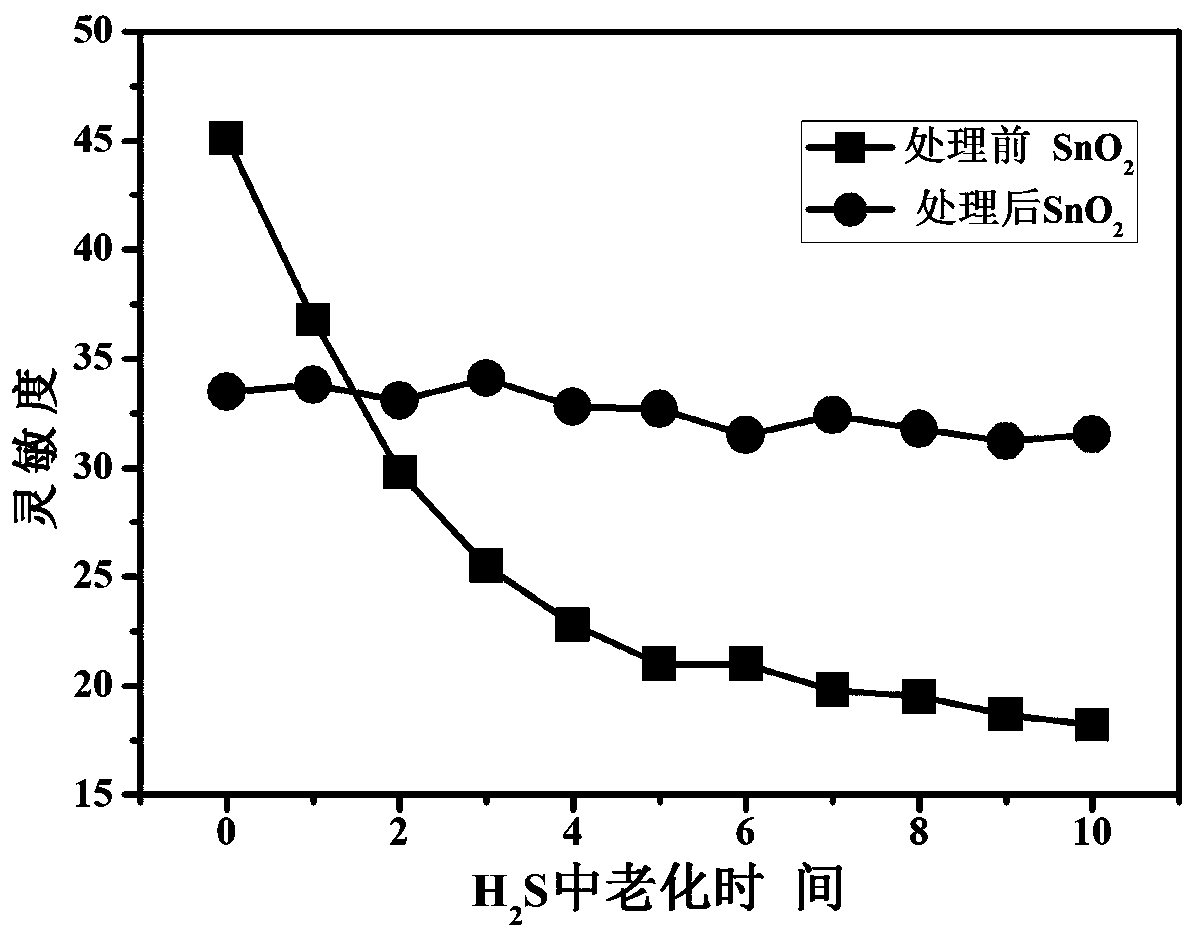Method for improving stability of hydrogen sulfide-sensitive tin dioxide gas sensor material
A gas-sensing material, tin dioxide technology, applied in the field of gas-sensing sensors, can solve problems such as poor stability
- Summary
- Abstract
- Description
- Claims
- Application Information
AI Technical Summary
Problems solved by technology
Method used
Image
Examples
Embodiment 1
[0018] commercial SnO 2 Nanomaterials are sensitive materials. Prepare 200mL of sodium thiosulfate aqueous solution with a concentration of 0.1mol / L, add appropriate amount of SnCl 4 ·5H 2 O, weighed SnO 2 The powder is placed in the above solution, sodium thiosulfate: SnCl 4 ·5H 2 O: SnO 2 The molar ratio is 3:1:30, stir for 3 hours, add 20 mL of tartaric acid; place in a reaction kettle, react at 120 °C for 3.5 hours; wait until the temperature drops to room temperature, centrifuge and dry the sample;
[0019] Put the above sample precursor and urea into a high-energy ball mill, the mass ratio of precursor to urea is 3:1, ball mill at 350 r / min in Ar atmosphere for 8 hours, and then put it in a muffle furnace for 5 hours at 450 °C. , to obtain the surface porous SnSO4-modified SnO 2 Nano powder.
[0020] figure 1 is a commercial SnO 2 With the sample treated in this example, the H of 10 ppm 2 Sensitivity comparison chart of S gas, the working temperature is 230 ℃,...
Embodiment 2
[0022] commercial SnO 2 Nanomaterials are sensitive materials. Mix 200mL of sodium thiosulfate aqueous solution with a concentration of 0.3mol / L, add appropriate amount of SnCl 4 ·5H 2 O, weighed SnO 2 The powder is placed in the above solution, sodium thiosulfate: SnCl 4 ·5H 2 O: SnO 2 The molar ratio was 2:1:30, stirred for 3 hours, and 30 mL of malic acid was added; placed in a reaction kettle, reacted at 120 °C for 5 hours; when the temperature dropped to room temperature, the sample was centrifuged and dried.
[0023] Put the above sample precursor and urea into a high-energy ball mill, the mass ratio of the precursor to urea is 5:1, ball mill at 300 r / min for 10 hours in an Ar atmosphere, and then put it into a muffle furnace for calcination at 350 °C for 6 hours , to obtain the surface porous SnSO4-modified SnO 2 Nano powder.
[0024] This embodiment and embodiment 1 adopt the same commercial SnO 2 , the treated sample reacts to 10 ppm H 2 S gas sensitivity in...
Embodiment 3
[0026] SnO synthesized by hydrothermal method 2 Nanomaterials are sensitive materials. Prepare 200mL of sodium sulfite aqueous solution with a concentration of 0.2mol / L, add appropriate amount of SnCl 4 ·5H 2 O, weighed SnO 2 The powder is placed in the above solution, sodium sulfite: SnCl 4 ·5H 2 O: SnO 2 The molar ratio was 2:1:40, stirred for 3 hours, added 60 mL of citric acid; placed in a reaction kettle, reacted for 3 hours at 180 ° C; when the temperature dropped to room temperature, the sample was centrifuged and dried;
[0027] Put the above sample precursor and urea into a high-energy ball mill with a mass ratio of precursor to urea of 5:1, ball mill for 2 hours at 500 r / min in an Ar atmosphere, and then put it into a muffle furnace for calcination at 350 °C for 6 hours , to obtain the surface porous SnSO4-modified SnO 2 Nano powder.
[0028] SnO directly synthesized by hydrothermal method 2 powder to 10 ppm H 2 S gas sensitivity at 73.2, at H 2 After be...
PUM
 Login to View More
Login to View More Abstract
Description
Claims
Application Information
 Login to View More
Login to View More - R&D
- Intellectual Property
- Life Sciences
- Materials
- Tech Scout
- Unparalleled Data Quality
- Higher Quality Content
- 60% Fewer Hallucinations
Browse by: Latest US Patents, China's latest patents, Technical Efficacy Thesaurus, Application Domain, Technology Topic, Popular Technical Reports.
© 2025 PatSnap. All rights reserved.Legal|Privacy policy|Modern Slavery Act Transparency Statement|Sitemap|About US| Contact US: help@patsnap.com

